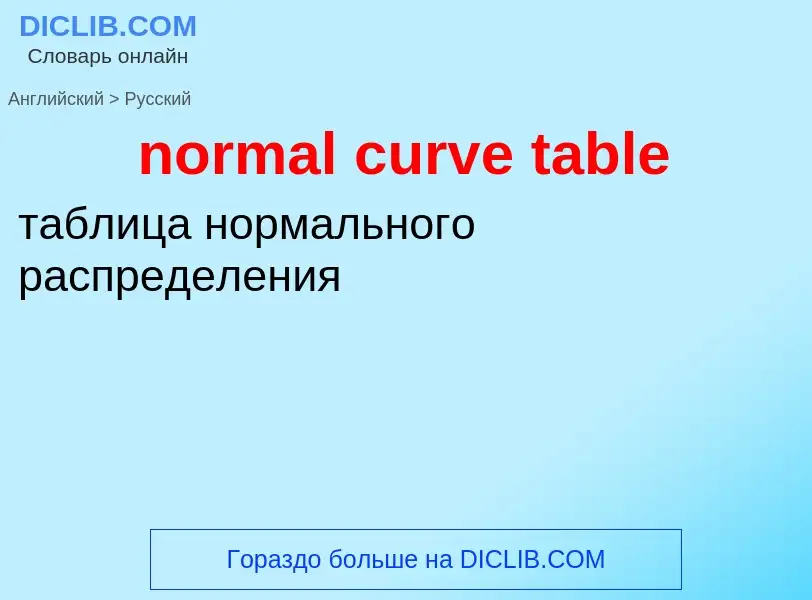Перевод и анализ слов искусственным интеллектом
На этой странице Вы можете получить подробный анализ слова или словосочетания, произведенный с помощью лучшей на сегодняшний день технологии искусственного интеллекта:
- как употребляется слово
- частота употребления
- используется оно чаще в устной или письменной речи
- варианты перевода слова
- примеры употребления (несколько фраз с переводом)
- этимология
normal curve table - перевод на русский
['belkə:v]
общая лексика
кривая нормального распределения
математика
колоколообразная
гауссова кривая
Википедия
In educational statistics, a normal curve equivalent (NCE), developed for the United States Department of Education by the RMC Research Corporation, is a way of normalizing scores received on a test into a 0-100 scale similar to a percentile rank, but preserving the valuable equal-interval properties of a z-score.
It is defined as:
- 70770 + /qnorm(.99) × z
or, approximately
- 50 + 21.063 × z,
where z is the standard score or "z-score", i.e. z is how many standard deviations above the mean the raw score is (z is negative if the raw score is below the mean). The reason for the choice of the number 21.06 is to bring about the following result: If the scores are normally distributed (i.e. they follow the "bell-shaped curve") then
- the normal equivalent score is 99 if the percentile rank of the raw score is 99;
- the normal equivalent score is 50 if the percentile rank of the raw score is 50;
- the normal equivalent score is 1 if the percentile rank of the raw score is 1.
This relationship between normal equivalent scores and percentile ranks does not hold at values other than 1, 50, and 99. It also fails to hold in general if scores are not normally distributed.
The number 21.06 was chosen because
- It is desired that a score of 99 correspond to the 99th percentile;
- The 99th percentile in a normal distribution is 2.3263 standard deviations above the mean;
- 99 is 49 more than 50—thus 49 points above the mean;
- 49/2.3263 = 21.06.
Normal curve equivalents are on an equal-interval scale. This is advantageous compared to percentile rank scales, which suffer from the problem that the difference between any two scores is not the same as that between any other two scores (see below or percentile rank for more information).
The major advantage of NCEs over percentile ranks is that NCEs can be legitimately averaged.

![[[Carl Friedrich Gauss]] discovered the normal distribution in 1809 as a way to rationalize the [[method of least squares]]. [[Carl Friedrich Gauss]] discovered the normal distribution in 1809 as a way to rationalize the [[method of least squares]].](https://commons.wikimedia.org/wiki/Special:FilePath/Carl Friedrich Gauss.jpg?width=200)

![[[Pierre-Simon Laplace]] proved the [[central limit theorem]] in 1810, consolidating the importance of the normal distribution in statistics. [[Pierre-Simon Laplace]] proved the [[central limit theorem]] in 1810, consolidating the importance of the normal distribution in statistics.](https://commons.wikimedia.org/wiki/Special:FilePath/Pierre-Simon Laplace.jpg?width=200)
![The [[bean machine]], a device invented by [[Francis Galton]], can be called the first generator of normal random variables. This machine consists of a vertical board with interleaved rows of pins. Small balls are dropped from the top and then bounce randomly left or right as they hit the pins. The balls are collected into bins at the bottom and settle down into a pattern resembling the Gaussian curve. The [[bean machine]], a device invented by [[Francis Galton]], can be called the first generator of normal random variables. This machine consists of a vertical board with interleaved rows of pins. Small balls are dropped from the top and then bounce randomly left or right as they hit the pins. The balls are collected into bins at the bottom and settle down into a pattern resembling the Gaussian curve.](https://commons.wikimedia.org/wiki/Special:FilePath/Planche de Galton.jpg?width=200)

![The ground state of a [[quantum harmonic oscillator]] has the [[Gaussian distribution]]. The ground state of a [[quantum harmonic oscillator]] has the [[Gaussian distribution]].](https://commons.wikimedia.org/wiki/Special:FilePath/QHarmonicOscillator.png?width=200)
